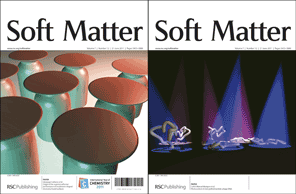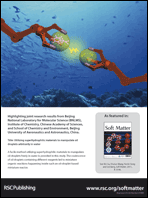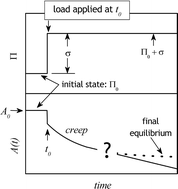Announcing the 7th International Symposium on Stimuli-Responsive Materials (October 24-26th, 2011 in Hattiesburg, MS, USA). Leading scientists from a variety of disciplines will discuss recent advances in adaptive materials at the interfaces of chemistry, physics, biology, and engineering. This symposium will build on a successful six year history of assembling experts in the area of stimuli-responsive/smart materials to discuss issues related to fundamental science and real-world applicability. For more information, visit the website here.
Archive for the ‘Uncategorized’ Category
Soft Matter Issue 12 is out now!
You can read the full issue here…
The paper featured on the outside front cover is ‘Origin of the superior adhesive performance of mushroom-shaped microstructured surfaces’ by G. Carbone, E. Pierro and S. N. Gorb. The inside front cover features work by Y. L. Sun, N. K. Mani, D. Baigl, T. Gisler, A. P. Schröder and C. M.l Marques: ‘Photocontrol of end-grafted lambda-phage DNA’ .
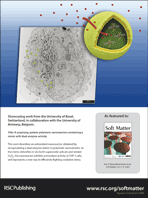 Showcasing work from the University of Basel, Switzerland, in collaboration with the University of Antwerp, Belgium- ‘A surprising system: polymeric nanoreactors containing a mimic with dual-enzyme activity’ by V. Balasubramanian, O. Onaca, M. Ezhevskaya, S. Van Doorslaer, B. Sivasankaran and C. G. Palivan.
Showcasing work from the University of Basel, Switzerland, in collaboration with the University of Antwerp, Belgium- ‘A surprising system: polymeric nanoreactors containing a mimic with dual-enzyme activity’ by V. Balasubramanian, O. Onaca, M. Ezhevskaya, S. Van Doorslaer, B. Sivasankaran and C. G. Palivan.
Also included in the issue is an Emerging Area article:
Liquid marbles: principles and applications by Glen McHale and Michael I. Newton
And the following reviews:
- Morphology of polymer-based bulk heterojunction films for organic photovoltaics, M.s A. Ruderer and P. Müller-Buschbaum
- Dielectric properties of soft-particles in aqueous solutions, C. Cametti
- Conditions for and characteristics of nonaqueous micellar solutions and microemulsions with ionic liquids, O. Zech and W. Kunz

Soft Matter makes the news!
 Soft Matter article on a gel that can fix back aches has been reported in the Daily Mail and the Telegraph. The work by Dr Brian Saunders and Professor Tony Freemont at the University of Manchester, involves the injection of a liquid containing microgel particles into the spine where the sponge-like particles expand to form a strong, load-bearing material.
Soft Matter article on a gel that can fix back aches has been reported in the Daily Mail and the Telegraph. The work by Dr Brian Saunders and Professor Tony Freemont at the University of Manchester, involves the injection of a liquid containing microgel particles into the spine where the sponge-like particles expand to form a strong, load-bearing material.
Soft Matter Issue 11, 2011, out now!
Soft Matter issue 11 is out now!
You can read the full issue here…
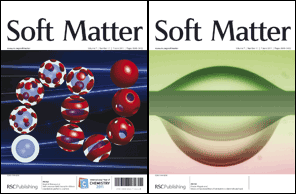
The paper featured on the outside front cover is ‘Self-consistent field theory for diblock copolymers grafted to a sphere’ by Bart Vorselaars, Jaeup U. Kim, Tanya L. Chantawansri, Glenn H. Fredrickson and Mark W. Matsen. The inside front cover highlights work by Hüseyin Burak Eral, Jolet de Ruiter, Riëlle de Ruiter, Jung Min Oh, Ciro Semprebon, Martin Brinkmann and Frieder Mugele: ‘Drops on functional fibers: from barrels to clamshells and back’.
Bin Su, Shutao Wang, Yanlin Song and Lei Jiang highlight their recent work on ‘Utilizing superhydrophilic materials to manipulate oil droplets arbitrarily in water‘ on the back cover of the issue.
The following review articles are included in the issue:
- Soft nanoparticles (thermo-responsive nanogels and bicelles) with biotechnological applications: from synthesis to simulation through colloidal characterization
- Softening bioactive glass for bone regeneration: sol–gel hybrid materials
- Polylactide (PLA)-based amphiphilic block copolymers: synthesis, self-assembly, and biomedical applications

Soft Matter article highlighted in ChemistryWorld
Ionic liquid advance over saline-based lenses
Ionic liquids are the key to observing improved performance and wider temperature ranges for variable focus lenses over conventional saline alternatives, report scientists in China.
Electrowetting-based variable focus liquid lenses (EVFLL) have been used in mobile phones, barcode readers and other optical equipment, in which the conductive liquid inside the lenses is currently limited to saline. In applications such as these, saline can only work in a narrow temperature range as it may evaporate or freeze in extreme temperatures. The lenses also need to operate in a wide spectral range, but again saline is restrictive here as it becomes opaque in the near infrared region – not ideal for optical devices… Read the rest of the article here…
Or for the original paper read here: Xiaodong Hu, Shiguo Zhang, Chao Qu, Qinghua Zhang, Liujin Lu, Xiangyuan Ma, Xiaoping Zhang and Youquan Deng, Soft Matter, 2011, Advance Article, DOI: 10.1039/C1SM05585B
Recent Hot Articles: Creep compliance, uniform vesicles and polymer nanocapsule formation
Read these Hot Articles for free until June 12:
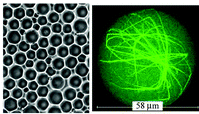 The ability to tune size and content of microscopic vesicles is hugely important for the chemical, food and biomedical industries. Continuous droplet interface crossing encapsulation (cDICE) was used to develop a high throughput low cost method for the synthesis of monodisperse vesicle suspensions in minutes. Droplets are continuously dripped from a capillary and simultaneously forced through an interface using centrifugal force. Manouk Abkarian, Etienne Loiseau and Gladys Massiera, Soft Matter, 2011, 7, 4610-4614, DOI: 10.1039/C1SM05239J
The ability to tune size and content of microscopic vesicles is hugely important for the chemical, food and biomedical industries. Continuous droplet interface crossing encapsulation (cDICE) was used to develop a high throughput low cost method for the synthesis of monodisperse vesicle suspensions in minutes. Droplets are continuously dripped from a capillary and simultaneously forced through an interface using centrifugal force. Manouk Abkarian, Etienne Loiseau and Gladys Massiera, Soft Matter, 2011, 7, 4610-4614, DOI: 10.1039/C1SM05239J
The dilational flow properties of polymer films are studied using creep compliance. Mobile polymers constrained to a quasi-2D conformation have different flow properties to those of the bulk system. The compliance curves allowed calculation of the viscoelastic parameters and relaxation times of the Langmuir films, fully consistent with previous rheology experiments.
Hani Hilles and Francisco Monroy, Soft Matter, 2011, Advance Article, DOI: 10.1039/C1SM05255A
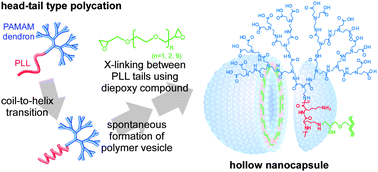 Polymer vesicles to hollow nanocapsules:
Polymer vesicles to hollow nanocapsules:
Head-tail type polycation self-assemblies of polyamidoamine dendron and poly(L-lysine) were cross-linked to form hollow nanocapsules. The nanocapsules show unique pH dependent properties, such as change in size and swelling.











